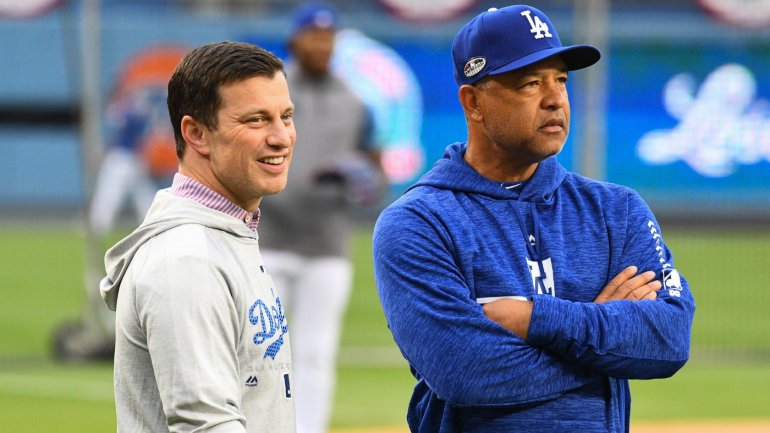
Last week, the San Diego Padres made headlines by acquiring Blake Snell and Yu Darvish, a pair of frontline veteran starters, in trades with the Tampa Bay Rays and the Chicago Cubs. The Padres found the time to sign Korean infielder Ha-Seong Kim, too, giving them a deeper and more formidable roster than they had last season.
It's natural to wonder if the Padres, who finished six games back in the National League West in the shortened 2020 campaign, now have what it takes to end the Los Angeles Dodgers' eight-year run of division titles. It's also natural to wonder if and how the Dodgers will respond.
Thus far this winter the Dodgers have played it slow and low, with relievers Corey Knebel and Tommy Kahnle (expected to miss the 2021 season) serving as their only 40-player roster additions. At some point, the Dodgers will have to re-sign (or replace) free agents Justin Turner, Joc Pederson, and Enrique Hernandez. (Knebel seems to serve as a logical replacement for Blake Treinen.) That's without factoring in the possibility that the Dodgers will want additional rotation help, depending on whether or not David Price intends to play in 2021 after opting out of last season.
The best offseasons take place in imaginative minds. There, the Dodgers can swing from the heels by acquiring another All-Star of their own. Maybe it's as easy as signing Trevor Bauer to a large one-year deal, or luring DJ LeMahieu away from the Bronx. The reigning World Series champs could also try snagging Nolan Arenado in a trade, or maybe something more complicated, like pulling in two quality players from teams looking to dump payroll: be it Sonny Gray and Eugenio Suarez, or Francisco Lindor and Carlos Carrasco.
Whatever the Dodgers intend to do (or not do), it's worth knowing about their Competitive Balance Tax situation, as well as the status of their farm system. Those two dynamics, as much as anything, tend to determine what a team can and can't do. With that in mind, let's summarize both.
1. CBT status
If you're unfamiliar with the CBT, it's Major League Baseball's spin on a luxury tax. You can read more about how it works here, but the Cliff's Notes version is that teams are penalized (often a trifling amount) if the annual average salaries (plus benefits) of their 40-player roster exceeds the magic number. Said "magic number" is now $210 million. Those penalties steepen for repeat offenders, and they start to impact a team's draft picks if they dare to have a CBT number more than $40 million above the threshold.
Although the Dodgers were projected to exceed the tax line by more than $17 million in 2020, they avoided that fate thanks to Price's opt-out and a midseason trade of Ross Stripling. Their current figure sits $20 million below the threshold, according to Cot's Contracts. Clearly odd things can happen, but it seems highly unlikely that the Dodgers will avoid the tax again this upcoming season. If they did nothing else but re-sign Turner -- without giving him a raise, mind you -- they would be bumping against the tax line.
The question shouldn't be "will the Dodgers spend into the tax zone"; it's "how deep into the tax zone are they willing to go?" There's no way of knowing under normal circumstances, let alone during a pandemic. If the Dodgers were willing to exceed the tax line by $17 million again, then they would have closer to $40 million in wiggle room. That doesn't mean the Dodgers can hand out only $40 million in 2021 money, either -- in theory, they could acquire a player with a higher salary than their CBT number.
And if the Dodgers really want to flex their financial might, they could add an additional $15 to 20 million to their 2021 CBT bill without triggering the worst penalties. That doesn't seem likely to be their plan, but we're just laying out what they could do here.
2. Farm system status
Money shouldn't be an issue for the Dodgers, but they might find it a touch more painful than it has been in the past to part with the prospect cost of a major trade.
The Dodgers have graduated and dealt a lot of young talent in recent years: Will Smith, Dustin May, Gavin Lux, Tony Gonsolin, Alex Verdugo, Jeter Downs among them. That, plus constantly picking later in the draft, has left their farm in a relatively subdued state; there are solid prospects present still, it's just not overflowing with slam-dunk, high-end types like it has been throughout the rest of Andrew Friedman's tenure.
This year's CBS Sports' top Dodgers prospects list (last winter's list with draftees added in and graduations stripped out) included catchers Keibert Ruiz and Diego Cartaya; right-handers Josiah Gray and Clayton Beeter; and third baseman Kody Hoese.
The Dodgers have a number of other prospects who could become useful big-league contributors: be it infielders Michael Busch, Miguel Vargas and Jacob Amaya; righties Bobby Miller, Andre Jackson, and Gerardo Carrillo; or outfielder Andy Pages.
So, can the Dodgers respond to the Padres' moves with a big one of their own? Yes, especially if the other team is as invested in the financial ramifications as it is the prospect return. Given the state of baseball, that almost seems like a certainty.


















